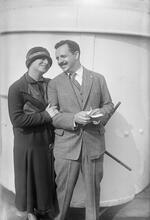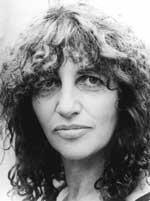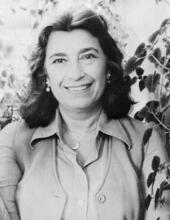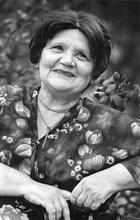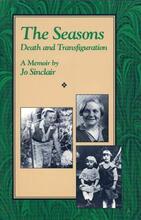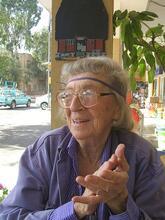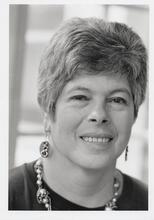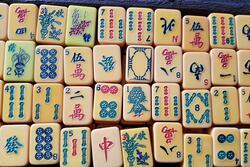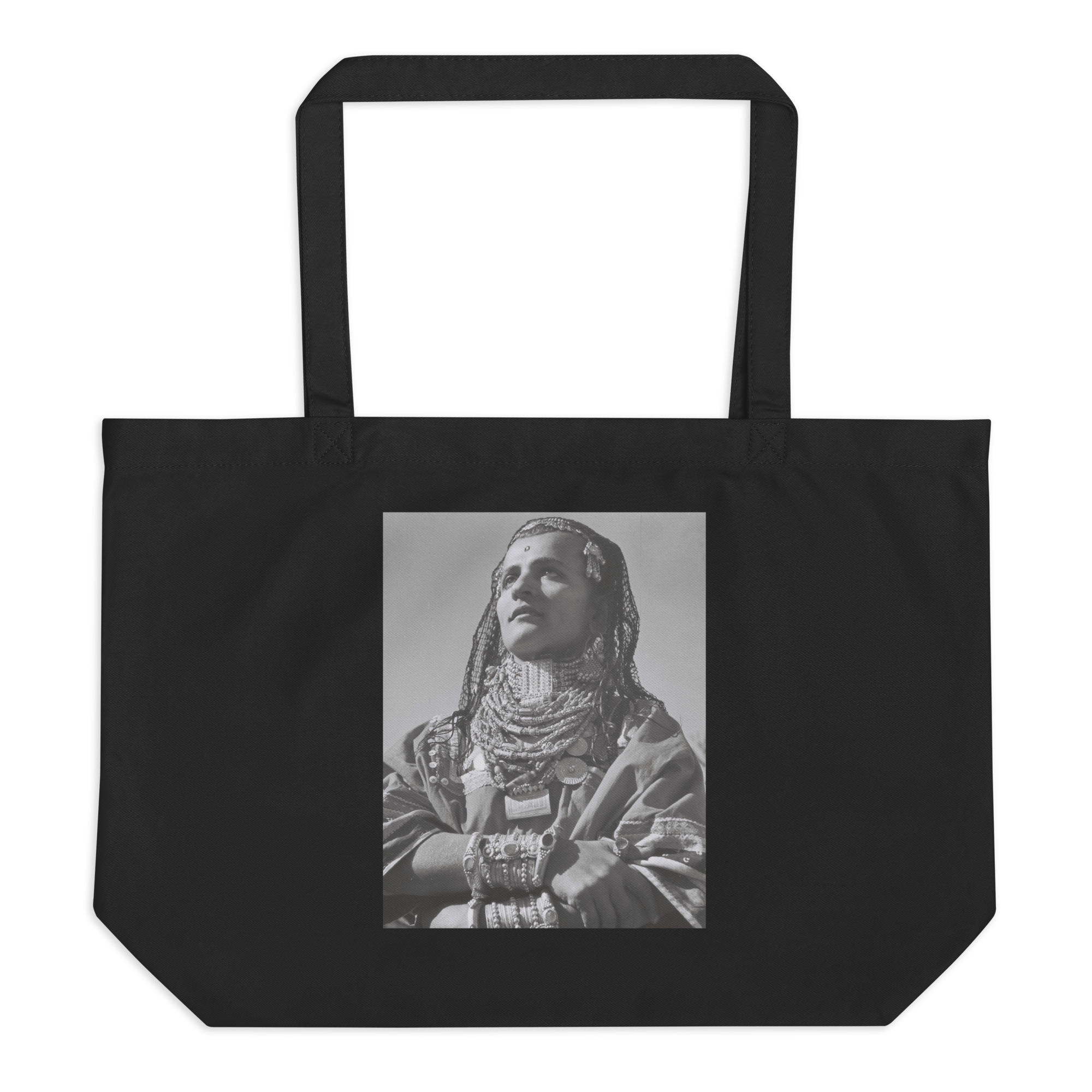Jacqueline Shohet Kahanoff
Jacqueline Shohet Kahanoff was an Egyptian-Jewish essayist, novelist, journalist, and literary critic. Born in Egypt, she moved to the United States in 1940, where she pursued higher education. She launched her writing career in the United States, winning a fellowship to support the publication of her novel Jacob’s Ladder (1951). She later relocated to France and in 1954 settled in Israel, where she produced her most influential work. Shohet Kahanoff is best known for promoting “Levantinism,” a social model for coexistence in Israel—a concept she articulates most fully in her “A Generation of Levantines” essays (1959). Her writings have inspired generations of Sephardi and Mizrahi writers in Israel. Although she is best remembered for her work published in Hebrew translation in Israeli journals, Shohet Kahanoff wrote in English and French throughout her career.
Early Life
Jacqueline Shohet was born in Cairo, Egypt, on May 18, 1917. Her mother, Yvonne Chemla, was born in Egypt to a family of Tunisian Jews who owned the Chemla Frères department store in Cairo. Jacqueline’s father, Joseph Shohet, immigrated to Egypt from Iraq with his parents and became a successful cotton trader. Jacqueline grew up in a multilingual household; the family spoke French at home, but her father was most comfortable speaking and reading Arabic. The Shohet family was sufficiently well-off to employ a series of British nannies and governesses in their home to educate Jaqueline and her sister Josette in English.
Education and Early Fiction
Jacqueline attended the Lycée Français in Cairo and in 1935 earned her Baccalaureate—the French national academic qualification taken at the end of high school. In 1938-1939, she studied French law in Cairo, just at the time the mixed courts—the legal system in which French law was practiced in Egypt—were being disbanded. At this time she also began exhibiting her acute social awareness in early pieces she published in Francophone literary journals such as Images. Some light-hearted sketches she published in the late 1930s aimed to accurately represent the experiences of young women in Cairo.
In 1940, Jacqueline married Israel Margoliash, an Jews of European origin and their descendants, including most of North and South American Jewry.Ashkenazi resident of Cairo who held United States citizenship, and she sailed to America. The couple settled in Chicago; Israel lived in residence at the hospital where he trained, while Jacqueline, living on her own, enrolled in secretarial courses at the Central YMCA College and took odd jobs.
In 1942 Jacqeline left Chicago—and her husband—for New York, where she enrolled in Columbia University, earning a BA in History (1944) and an MA in Journalism (1945). She also took courses at the New School, where she circulated with European intellectuals who had found refuge in the United States from the war in Europe, including Claude Lévi-Strauss, Roman Jakobson, Alexander Koyré, and Claude Vigée. Jacqueline became intellectually and romantically involved with Lévi-Strauss at a critical moment in their respective intellectual development.
While in New York, Jacqueline began writing and publishing short stories that reflected her keen attention to ethnographic detail. She would later use the term “sociologically honest” to describe her approach to writing fiction. In 1946, her story “Such is Rachel” won an Atlantic First prize and was published in The Atlantic. She was awarded a Houghton Mifflin fellowship to develop the story into a novel, published as Jacob’s Ladder (1951). These semi-autobiographical works of fiction described the coming of age of a bourgeois Egyptian Jewish girl trying to assert her voice within in her patriarchal Lit. "Eastern." Jew from Arab or Muslim country.Mizrahi family, to wrest her independence from her overbearing British nannies, and to express her solidarity with Egyptian nationalists, even as she recognizes her exclusion from their movement.
Journalism, Essays, and Literary Criticism
In the early 1950s, Jacqueline joined her sister, Josette, in Paris, where she reconnected with another Ashkenazi Jew from her social circle in Cairo, Alexander Kahanoff, an acoustical engineer. Jacqueline wed Alexander in 1952, and the couple immigrated to Israel in 1954.
Beginning in the 1950s and throughout the rest of her career, Jacqueline Shohet Kahanoff worked as freelance journalist and literary critic for nearly every major English- and Hebrew-language daily newspaper in Israel, as well as a wide range of magazines. She also regularly published pieces in the American Jewish press. Although Shohet Kahanoff learned to speak Hebrew, she never felt comfortable writing in Hebrew. All of her writings published in Hebrew were translated from her original compositions in English or French.
Shohet Kahanoff’s second big break came in 1958, following the publication of her essay “Reflections of a Levantine Jew” in the American journal The Jewish Frontier. The essay caught the attention of Nessim Rejwan, an anglophone Iraqi Jewish writer also living in Israel. Rejwan introduced Jaqueline to Aharon Amir, who was about to launch an intellectual journal, Keshet. For the rest of Shohet Kahanoff’s career, Aharon Amir served as the unacknowledged translator of her English and French manuscripts into Hebrew. Amir’s journal became a platform for Shohet Kahanoff’s long-form social critique and literary criticism.
Between 1954 and 1958, a period of great enmity and conflict between Egypt and Israel, Jacqueline published under a pseudonym to protect her parents, who were still living in Cairo. After her parents settled in Israel, she began publishing under her own name and asserting her voice as an essayist. When her influential cycle of four essays, “Generation of Levantines,” was published in Keshet in 1959, her byline read Jacqueline Kahanoff, the name by which she is best remembered. In these essays that interweave personal narrative and sociocultural critique, Shohet Kahanoff lays out her notion of Levantinism.
The word “Levantine” in English bears a pejorative connotation, referring disparagingly to a person from the Eastern Mediterranean of indistinct or culturally mixed origins. In Israel in the 1950s, following large waves of immigration from Arabic-speaking and Muslim-majority countries, Ashkenazi political and cultural leaders adopted the term “Levantini” in Hebrew to vilify what they saw as the backward cultural practices of these new immigrants—practices they feared would negatively influence Israeli society. Shohet Kahanoff vociferously opposed discriminatory policies against these Mizrahi immigrants. She reappropriated the term “Levantine,” giving it a positive spin. Shohet Kahanoff maintained that the cultural heritage of all Jews should be valued. For her, Levantinism meant embracing the cultural integration of all Jewish immigrants, a process she believed would lead to the development of a just, pluralist society with equal opportunity for all Jews in Israel. Integration of Jews from Arabic-speaking countries also would help Israel become culturally and linguistically closer to Palestinians and neighboring Arab countries, which she hoped would lead to a more peaceful future.
While Shohet Kahanoff is best known for the essays published in Hebrew in Keshet and other intellectual journals in Israel, she continued to earn a living as a journalist. She held a number of short-term positions as a writer and translator for various branches of the United Nations. In 1960 she published a book-length report in English on the Ramat-Hadassah-Szold Youth Aliyah for the UNESCO-sponsored Fédération Internationale des Communautés d’Enfants (FICE).
Through her literary criticism published in the Hebrew press, Shohet Kahanoff functioned as an important cultural mediator, introducing works of by a wide range of writers from around the world to Israeli readers. In addition to reviews of works by Jean Paul Sartre, Simone de Beauvoir, Peggy Guggenheim, and John Steinbeck, she wrote about Indo-Caribbean writer and 2001 Nobel laureate V. S. Naipaul, Asian American writer Santha Rama Rau, and Belgian Chinese writer Han Suyin. She published a series of articles on Japanese literature in the literary supplement of a widely read daily newspaper. In 1963, she edited a groundbreaking anthology of modern African short stories translated into Hebrew.
Throughout her career, as evidenced even in her earliest writing, Shohet Kahanoff paid particular attention to the social pressures on women and to the limits on their freedoms. By the 1970s, influenced by the rise of second-wave feminism in Israel and abroad, Shohet Kahanoff’s writing became more explicitly focused on women’s liberation. Her personal struggle against misogyny in the Israeli legal system also influenced the feminist turn in her writing. In 1972, Alexander Kahanoff filed for divorce in Israeli Rabbinical Court on the grounds of “rebelliousness.” When the divorce was granted, Jaqueline was denied property rights, since Jewish law did not recognize the couple’s civil marriage in France. Jacqueline filed suit, claiming that the Israeli Rabbinical Court had no jurisdiction since the couple had been wed abroad. Shohet Kahanoff presented her case for the rights of women before the Israeli Supreme Court [Kahanoff v. Tel Aviv District Rabbinical Court (1975)]. To her disappointment, the Supreme Court ruled in favor of the jurisdiction of the Rabbinical Court over foreign marriages, a decision that became legal precedent.
Shohet Kahanoff’s writing about the medical establishment also made a lasting impact. In 1967, she published “To Die a Modern Death,” about end-of-life care for her father in Israel. Her appeal for compassionate care became a standard text in the curriculum for social workers in Israel. In 1976 Shohet Kahanoff was diagnosed with breast cancer. She documented her own medical treatment in a series of articles, “Diary of an Illness,” published in the popular women’s monthly At, where she was a regular contributor.
In 1978, Shohet Kahanoff published a Hebrew-language collection of her long-form intellectual essays, Mi Mizrah Shemesh [From East the Sun]. This collection contained many of her early essays reflecting on her childhood in Egypt.
Response to Peace Treaty with Egypt
In November 1977, Egyptian president Anwar Sadat visited Israel, launching peace negotiations that culminated in the 1979 peace treaty between Egypt and Israel. These developments were closely followed and celebrated by members of the Egyptian Jewish diaspora. In articles published between 1977 and 1979, Shohet Kahanoff expressed her hopes for a warm peace between Israel and Egypt. She sent a copy of From East the Sun to Jehan Sadat, the Egyptian first lady.
Legacy
Jacqueline Shohet Kahanoff died on October 24, 1979. After her death, her writing began a slow slide into obscurity. In the 1990s, novelist Ronit Matalon (1959-2017) championed Shohet Kahanoff’s work, introducing her to a new generation of Lit. "Eastern." Jew from Arab or Muslim country.Mizrahi writers in Israel. In recognition of Shohet Kahanoff’s immense intellectual contributions, anthologies of her essays were published in Hebrew in 2005 and 2022 and in English in 2011, and her novel Jacob’s Ladder was published in Hebrew translation for the first time in 2015.
Selected Works by Jacqueline Shohet Kahanoff
In English
Jacob’s Ladder. London: Harvill Press, 1951.
Mongrels or Marvels: The Levantine Writings of Jacqueline Shohet Kahanoff, edited by Deborah Starr and Sasson Somekh. Palo Alto, CA: Stanford University Press, 2011.
In Hebrew
Mi Mizrah Shemesh [From East the Sun]. Tel Aviv: Yariv, 1978.
Ben shene ʻolamot [Between Two Worlds], edited by David Ohana. Jerusalem: Keter, 2005.
Ba-Levant Noladu Kulanu [We were all born in the Levant], edited by David Ohana. Carmel, 2022.
Alon, Ktsiaa, “What Egypt’s Multicultural Past Teaches Us about Israel’s Present,” trans. Shaked Spier. +972 Magazine, December 28, 2014, https://www.972mag.com/what-egypts-multicultural-past-teaches-us-about-israels-present/
Hochberg, Gil Z. “‘Permanent Immigration’: Jacqueline Kahanoff, Ronit Matalon, and the Impetus of Levantinism.” Boundary 2: An International Journal of Literature and Culture 31, no. 2 (2004): 219–43.
Monterescu, Daniel, “Beyond the Sea of Formlessness: Jacqueline Kahanoff and the Levantine Generation.” Journal of Levantine Studies, Vol. 1 (2011). https://levantine-journal.org/product/beyond-the-sea-of-formlessness-jacqueline-kahanoff-and-the-levantine-generation/
Ohana, David. Jacqueline Kahanoff, A Levantine Woman. Indianapolis: Indiana University Press, 2023.
Rejwan, Nissim. “The Levantinism Scare.” In Outsider in the Promised Land: An Iraqi Jew in Israel, 68-90. Austin: University of Texas Press, 2006.

